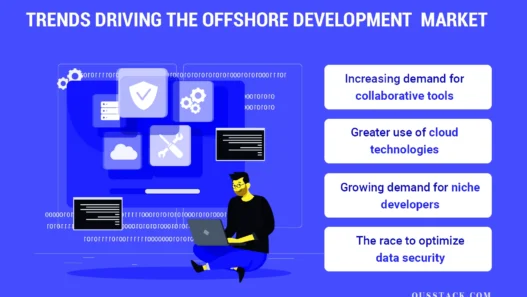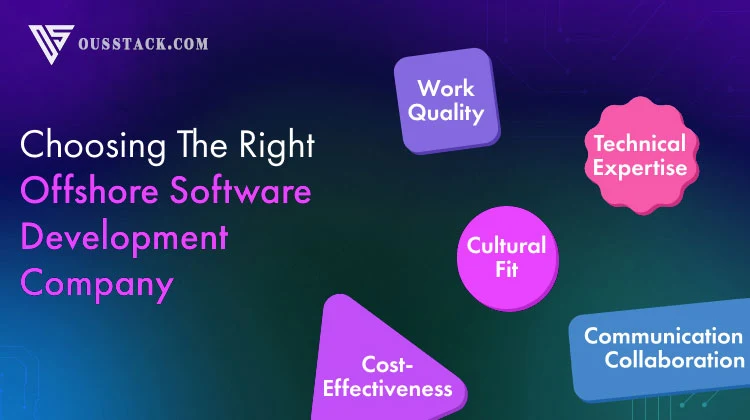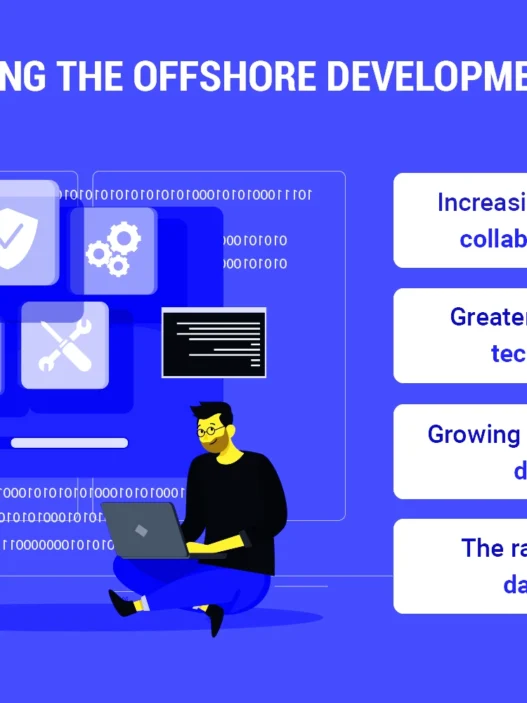The demand for offshore software development companies has skyrocketed in recent years, with the global IT outsourcing market projected to reach $1.06 trillion by 2031
This growth is driven by businesses seeking cost-efficient solutions, access to skilled talent, and faster project delivery. However, while offshore development offers immense potential, many companies face significant challenges when selecting the right partner. Issues such as communication gaps, inconsistent quality, and hidden costs can derail even the most promising projects.
These risks often leave businesses unsure of how to navigate the complex process of choosing a reliable offshore provider. To address this challenge, this guide provides a comprehensive framework to help you evaluate and select the best offshore software development companies or company a partner tailored to your specific needs. By following these proven steps, you can mitigate risks, ensure seamless collaboration, and achieve successful outcomes for your software projects. Whether you’re a startup or an established enterprise, this resource will equip you with the tools and insights needed to make informed decisions and maximize the value of your offshore partnership
For a broader understanding of offshore Software development, read our pillar guide: The Ultimate Guide to Offshore Software Development in 2025
Table of Contents
1. Why Offshore Software Development Companies?
Offshore software development companies or partners has become a strategic choice for businesses seeking to optimize their operations and achieve competitive advantages. One of the most compelling reasons to adopt this approach is cost savings. By leveraging lower labor costs in regions with favorable economic conditions, companies can significantly reduce development expenses without compromising on quality. In addition to financial benefits, offshore development provides access to a global talent pool. This allows businesses to tap into specialized skill sets that may not be readily available locally, ensuring innovative solutions and high-quality outcomes.
Scalability is another key advantage of software offshore development can quickly scale their development teams up or down based on project requirements, ensuring flexibility and resource optimization. This adaptability is particularly beneficial for startups needing MVP (Minimum Viable Product) development, as they often operate with limited budgets and tight timelines. Offshore teams enable these startups to bring their ideas to life efficiently while maintaining cost-effectiveness.
Faster time-to-market is also a significant draw for businesses. With round-the-clock development cycles enabled by teams in different time zones, projects can progress more rapidly, helping companies stay ahead of competitors. Enterprises looking to scale their development teams find offshore partnerships invaluable, as they provide immediate access to skilled professionals without the delays associated with hiring locally. Additionally, companies lacking in-house technical expertise can rely on offshore providers to bridge gaps and deliver complex solutions These use cases highlight how offshore software development companies addresses critical business needs, making it an attractive option across industries.
2. Critical Factors to Evaluate Offshore Software Development Companies
A. Technical Expertise & Industry Experience
When evaluating offshore software development companies, technical expertise and industry-specific experience are paramount. It’s crucial to partner with a company that has a proven track record in your niche whether it’s healthcare, fintech, e-commerce, or another specialized field. For instance, a company that has built a SaaS platform for logistics will inherently understand scalability challenges better than a generalist firm. This domain knowledge can significantly reduce onboarding time and ensure that the final product aligns with industry standards.
To assess their expertise, request case studies, client testimonials, and portfolios. These resources provide tangible evidence of their capabilities and help you gauge their proficiency in the technologies relevant to your project. Additionally, consider asking about their team’s certifications and ongoing training programs, as these reflect their commitment to staying updated with the latest technological advancements.
B. Communication & Collaboration Practices
Effective communication is the backbone of any successful offshore partnership. One of the first things to evaluate is time zone overlap and language proficiency, particularly fluency in English or your preferred language of communication. A lack of alignment in working hours can lead to delays and misunderstandings, so ensure there is sufficient overlap to facilitate real-time collaboration.
Next, inquire about the tools they use for communication and project management, such as Slack, Jira, or Zoom. Ask about the frequency of updates and how they handle escalations or urgent issues. A red flag to watch for is the absence of a dedicated project manager. Without this role, accountability and coordination can suffer, leading to misaligned expectations and project delays.
C. Development Process & Quality Assurance
The development methodology an offshore company follows whether Agile, Waterfall, or a hybrid approach can significantly impact the success of your project. Agile methodologies are often preferred for their flexibility and iterative nature, allowing for quicker adjustments based on feedback.
Equally important is the company’s approach to quality assurance (QA). Inquire about their QA processes, including automated testing, code reviews, and bug-fixing policies. Pro tip: “Ask how they handle scope changes or mid-project pivots.” This question reveals their adaptability and ability to manage unforeseen challenges without compromising deadlines or quality.
D. Security & Data Privacy Compliance
Data security is a top concern when outsourcing software development. According to industry statistics,
“48% of businesses cite data security as their top concern with offshore partners”
To mitigate risks, verify that the company holds relevant certifications such as ISO 27001, GDPR compliance for European clients, or HIPAA for healthcare projects.
Additionally, review their policies on non-disclosure agreements (NDAs), intellectual property (IP) protection, and data encryption practices. Ensure that these measures are explicitly outlined in your contract to safeguard sensitive information. A reputable offshore partner will have robust security protocols in place to protect your data throughout the development lifecycle.
E. Pricing Models & Transparency
Pricing models play a critical role in determining the overall cost-effectiveness of your offshore partnership. Common models include fixed-price contracts, which are ideal for well-defined projects, and time-and-materials contracts, which offer more flexibility for evolving requirements.
Be vigilant about hidden costs, such as those associated with onboarding, maintenance, or additional features. For example, “Company A offers $25/hour but lacks transparency; Company B charges $30/hour with all-inclusive pricing.” While the hourly rate may seem higher with Company B, their transparent pricing structure could save you money in the long run by avoiding unexpected expenses. Always ask for a detailed breakdown of costs upfront to ensure clarity and avoid disputes later.
F. Cultural Fit & Long-Term Partnership Potential
Beyond technical skills and processes, cultural fit is a key factor in fostering a productive and enduring partnership. Evaluate the company’s values, work ethic, and responsiveness to determine if they align with your organization’s culture. A vendor that shares your vision and priorities reduces friction in long-term projects.
Scalability is another important consideration. As your business grows, can the offshore partner scale their services accordingly? Assess their ability to onboard additional resources, take on larger projects, and adapt to changing requirements. Remember, a successful offshore partnership is not just about completing a single project it’s about building a relationship that can evolve and thrive over time.
By carefully evaluating these six critical factors, you can identify an offshore software development companies or company that meets your needs and ensures the success of your projects.
“A vendor that aligns with your culture reduces friction in long-term projects.“
Oussama El Attar.
3. Step-by-Step Selection Process
Selecting the right offshore software development companies or a company partner requires a structured and methodical approach to ensure alignment with your business goals. The first step is to define your goals by outlining your budget, timeline, and preferred tech stack (e.g., React for front-end, Python for back-end, or AWS for cloud infrastructure). Clearly articulating these requirements will help you communicate effectively with potential partners and set realistic expectations.
Next, shortlist companies by leveraging platforms like Clutch, GoodFirms, or LinkedIn. These platforms provide reviews, ratings, and detailed profiles that can help you identify reputable firms with expertise in your desired technologies and industries. Aim to create a shortlist of 5–7 companies that align with your needs.
Once you’ve narrowed down your options, request proposals from the shortlisted companies. Compare their pricing models, timelines, and terms to evaluate how well they fit your project requirements. For instance, some companies may offer fixed-price contracts, while others may propose time-and-materials agreements. Pay attention to details such as deliverables, milestones, and hidden costs.
After reviewing proposals, conduct interviews with the top contenders. During these discussions, ask about their past projects, disaster recovery plans, and how they handle challenges like scope changes or technical roadblocks. This step allows you to assess their communication skills, problem-solving abilities, and overall compatibility with your team.
To further mitigate risks, start with a pilot project . Assign a small, non-critical task to test their skills, responsiveness, and ability to meet deadlines. A pilot project serves as a low-stakes trial run and helps build confidence in their capabilities before committing to a long-term partnership.
Finally, negotiate contracts to ensure all terms are clearly defined. Key elements to address include service-level agreements (SLAs), exit clauses, intellectual property (IP) ownership, and confidentiality agreements. A well-structured contract protects both parties and lays the foundation for a successful collaboration. By following this step-by-step process, you can select an offshore partner that meets your needs and delivers value over the long term.
4. Red Flags to Avoid

When selecting an offshore software development partner, being aware of red flags can save you from costly mistakes and ensure a successful collaboration. One major warning sign is vague proposals without clear deliverables . If a company’s proposal lacks specificity regarding timelines, milestones, or expected outcomes, it may indicate a lack of transparency or planning. Such ambiguity can lead to misunderstandings and unmet expectations down the line.
Another critical red flag is the lack of verifiable client references . Reputable companies should be able to provide references or case studies from previous clients. If a vendor is reluctant to share this information, it could signal inexperience or dissatisfaction among past customers. Always verify these references to confirm the company’s track record and reliability.
Be cautious of unusually low prices , as they often indicate corner-cutting. While cost savings are a key motivator for offshore development, excessively low rates may compromise quality, lead to hidden costs, or result in subpar work. Remember, the cheapest option is rarely the best in the long run.
Finally, poor responsiveness during the evaluation phase is a strong indicator of potential issues. If a company takes too long to reply or fails to address your questions thoroughly, it suggests a lack of professionalism and communication skills. Responsiveness during the evaluation phase is a preview of how they will handle your project once the partnership begins. By staying vigilant and avoiding these red flags, you can significantly increase your chances of finding a reliable offshore development partner.
Case Study of A Successful Offshore Partnership
How ThredUP Built a Scalable Platform with a Ukrainian Offshore Team
ThredUP, a leading online thrift store, needed a cost-effective yet skilled team to enhance their platform’s scalability and develop advanced features like secure payment processing and AI-driven inventory management. Instead of expanding their in-house team domestically, they partnered with Ukrainian developers known for their expertise in fintech and scalable systems.
The solution involved hiring an offshore team with deep experience in building secure, high-performance platforms. The Ukrainian team provided 24/7 support, ensuring seamless collaboration despite time zone differences. Their use of Agile methodologies allowed ThredUP to adapt quickly to market demands and deliver updates efficiently.
The result was transformative ThredUP successfully launched new platform features within six months, significantly under budget. The partnership not only reduced development costs but also accelerated innovation, enabling ThredUP to maintain its competitive edge in the fast-growing resale market.
This real-world example demonstrates how leveraging offshore expertise can drive efficiency, reduce costs, and accelerate product delivery making it a winning strategy for tech companies aiming to scale globally.
5. Tools & Resources
When searching for offshore software development companies, platforms like Clutch, Upwork, and Toptal are invaluable resources. Clutch provides detailed reviews and ratings of development firms, helping you identify top performers in your industry. Upwork and Toptal are excellent for connecting with freelance professionals or smaller teams, especially for short-term projects.
For drafting contracts, leverage free templates available online. Websites like Proposable offer customizable software development contract templates that include key elements such as pricing models, timelines, and intellectual property clauses. These resources ensure your agreements are comprehensive and legally sound.
Effective collaboration is critical to managing offshore teams, and tools like Trello, Asana, and GitHub streamline project management and communication. Trello and Asana are ideal for task tracking and organizing workflows, while GitHub supports version control and seamless code collaboration. By utilizing these tools and resources, you can simplify the process of finding, contracting, and working with offshore partners.
Conclusion
Due diligence is a critical process that protects businesses from potential risks and ensures informed decision-making. Whether in mergers and acquisitions, IT partnerships, or offshore software development companies, thorough due diligence helps assess the capabilities, reputation, and financial health of potential partners. It also safeguards against compliance issues, such as non-compliance with Anti-Money Laundering (AML) regulations, and prevents high-risk individuals or faulty architectures from jeopardizing your investment. Clear communication and structured evaluations further enhance the effectiveness of this process. By prioritizing due diligence, businesses can mitigate risks, avoid costly mistakes, and build successful, long-term collaborations that align with their strategic goals.
Ready to partner with a top-tier offshore team before that explore our pillar guide: The Ultimate Guide to Offshore Software Development in 2025














I\’m impressed by your writing style and the depth of your knowledge on this topic.
I\’m truly grateful for your support. Your positive feedback keeps me motivated.
I\’m so glad I found your site. Your posts are consistently excellent.